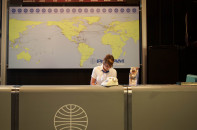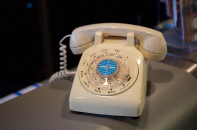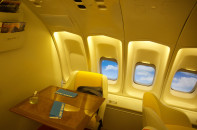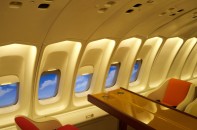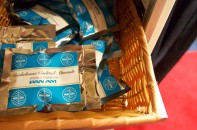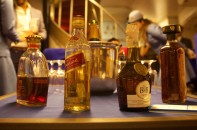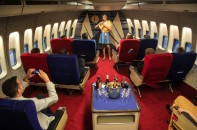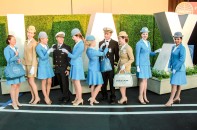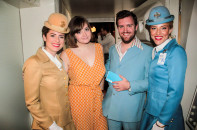Its logo is as recognizable as Coca-Cola’s, and up until 1991 its name was synonymous with the finest of air travel experiences. Hollywood has been obsessed with Pan Am and its Pantone-quality color palette for years—the mere mention of the airline’s name conjures up thoughts of Mad Men, Frank Abagnale, Jr., and The Beatles’ iconic 1964 arrival at JFK. There are very few corporations whose legacy can live on so long after the company itself has been shuttered or absorbed, but there’s something about what Pan Am meant to those passengers that keeps the name going even twenty-five years after its final flight. Why does the Pan Am flame burn so bright? And what about Pan Am’s allure makes the film studio Air Hollywood able to host dinners in an old plane hull for three-hundred bucks a pop?
As I sat waiting for my delayed flight in a captain’s chair in the middle of the Pan Am Experience’s Clipper Club—forty minutes and two vodka gimlet laps in—I had similar questions. After hearing about a fancy, retro dinner party, I knew I had to try it out, even though that meant spending a Saturday night playing pretend with a bunch of rich strangers. But, even though I was committed to lying about being a first-class newbie and rolling with whatever the evening threw at me, I was starting to worry that this fantasy evening was going to be just like any other flight. Never-ending delays and overwhelming restlessness.

Take me back in time / photo by Bennett Rankin
Travel posters for faraway places hung on the walls of the lounge (which is otherwise a large Air Hollywood soundstage), and memorabilia from Pan American World Airways’ glory days were displayed for all to see. Founded by the perfectly named Juan Trippe in 1927, Pan Am was an airline whose original first class passengers were large sacks of mail. But less than a decade into its existence, Trippe’s company transformed from a small fleet of cargo planes into an air travel conglomerate and quickly became the standard for luxury in the sky. With Pan Am leading the charge as the first commercial airliner to be able to heat and cook food in-flight, fliers began to associate Trippe’s empire with the comforts of home.
Being the best (and trying to monopolize the sky) meant that Trippe staked his claim by printing his logo on everything, from aircraft and uniforms to cutlery and amenities. Petite liquor bottles stamped with the Pan Am seal of approval and specialized four-course menus from voyages past were front and center in the Clipper Club’s curio cabinets. “Look at all the food they got!” exclaimed another soon-to-be passenger, an enthusiastic woman in a navy blue pillbox hat. While a first class experience now might conjure dreams of unlimited in-flight movies and free blankets, it seems that, from the 1950s up until quite recently, the promise of a good meal and a stiff drink was at the center of all air travel—regardless of what section you were sitting in.
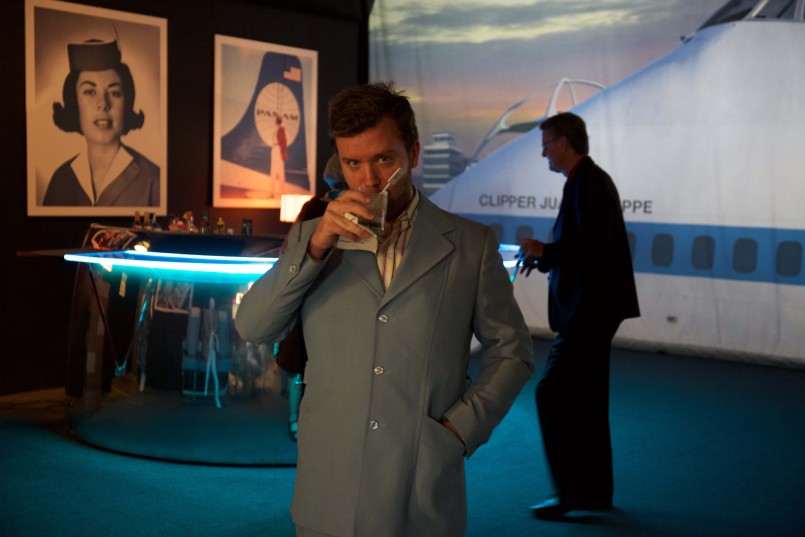
Awaiting takeoff in style / photo by Bailey Pennick
Just when the lounge’s ambiance was getting a bit stale, an announcement came through loud and clear over the speaker system: “Flight crew to the aircraft.” Then, just like in Catch Me If You Can, the Pan Am Experience crew floated through the Clipper Club to the tune of “Come Fly with Me” (which was playing for the fifth time). Laughing stewardesses and grinning crewmembers waved as they prepared the plane, a ’70s-era Boeing 747, for boarding. It didn’t matter how ridiculous this little show was in reality, you couldn’t help but want to wave to them; their costumed authority was not to be disobeyed or mocked.
Richard Foss breaks down the excitement and expectations of travelers and crews throughout the last century in his 2014 book Food in the Air and Space. Where we take flying for granted today—even viewing it as a hassle or necessary evil—the earliest atmospheric adventurers used these journeys as an excuse to show off their wealth to others. “The first people to fly were not doing so for transportation,” explains Foss. “They were aristocrats, thrill-seekers, and scientists whose sole commonality was that they were from the upper classes. They dressed for flights as they might for an afternoon of riding or walking on their estates.”
Four feet of unused cabin space separated my chair from the back of the seat in front of me. I teared up as I looked down and actually saw my feet.
The most-fashionable ark started to be filled, two by two, with passengers. “Feel free to move about the cabin and look around,” said a young flight attendant as I stepped onto the plane and back in time. I nodded and started to touch everything that I could. It looked so foreign, with its bright color scheme and ample legroom, and yet so familiar at the same time. As I wandered through the crew’s galley, I marveled at the darling blue-and-white Pan Am drink stirrers and paper coasters. It was like being in an interactive museum.
After pawing through the vintage magazines in the Clipper Class—the original business class invented by Trippe—I headed up the tight spiral staircase to check out the second-floor first-class dining room. Mod armchairs and sleek wooden tables adorned this intimate setting for the elite of the elite. Here I was, drooling over the stylish details of an old airplane. I was yearning for a nearly fifty-year-old reality that I never even knew I wanted.
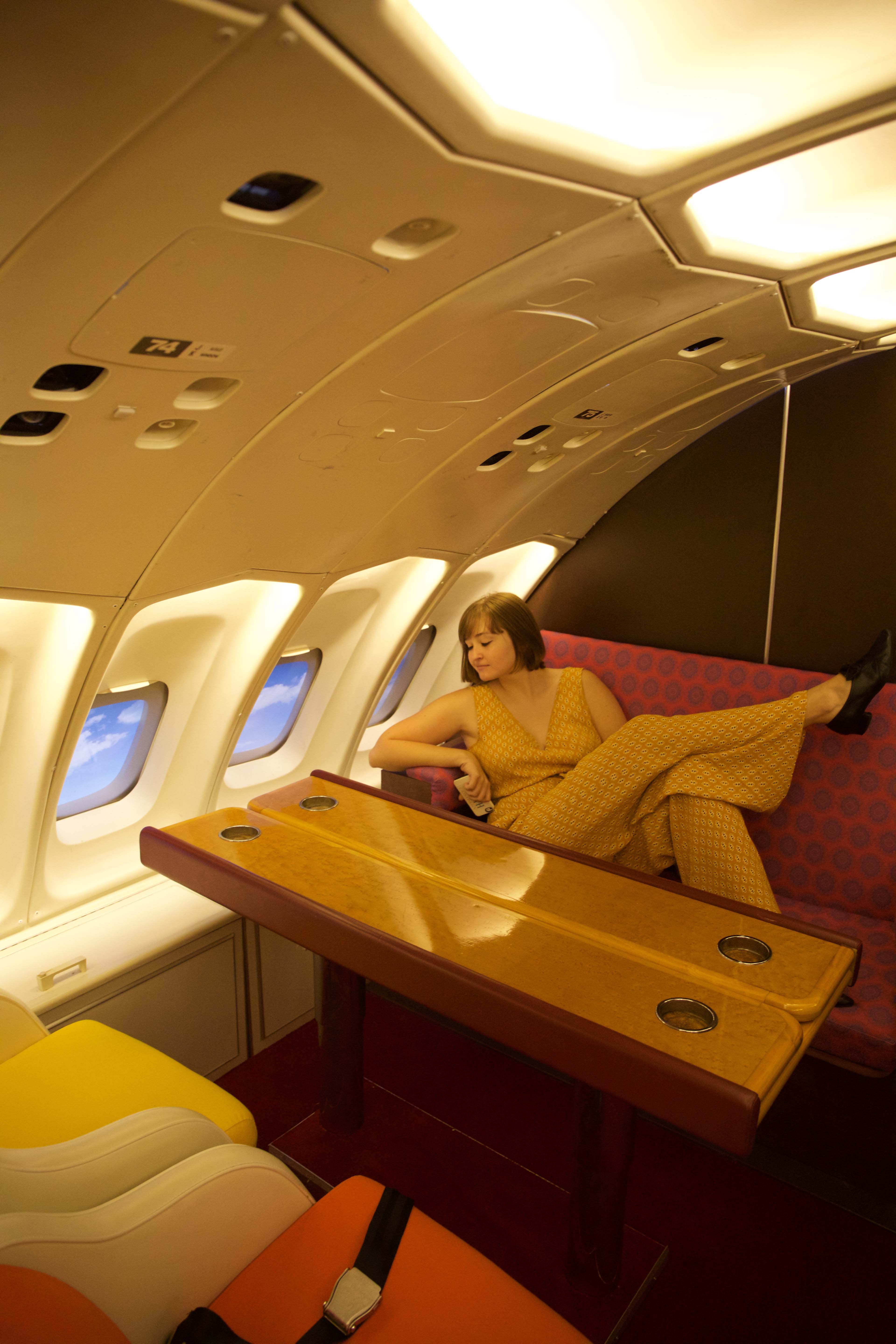
The author enjoying the comforts of the upstairs first-class dining room for a brief moment / photo by Bennett Rankin
Once most of the passengers were on, the upstairs gang—who paid fifty bucks extra for the night—kicked us regular ole upper-crust types out and we made our way to our assigned seats. Four feet of unused cabin space separated my chair from the back of the seat in front of me. I teared up as I looked down and actually saw my feet. Then I did a few seated Rockette kicks.
It was time for takeoff and my first glass of Moët & Chandon champagne—a generous pour in an original Pan Am glass. With each sip, I felt myself getting lighter and lighter. Was it the bubbles? Or were we actually traveling? It was definitely the bubbles, but at the end of a campy safety instruction video—where I learned that if the airplane was to start actually moving, to run like hell—our head stewardess informed us of our final destination: the 1970s. “I just hope we don’t hit turbulence!” joked a fellow passenger. Yeah, fighting through the Nixon Administration’s thunderous shit-storm would be rough on the nonexistent engines.
By the time we were airborne (which is what I now call two-and-a-half glasses of Moët), I noticed that something strange was happening on this flight—passengers were talking to each other. It spread like some sort of recycled air disease throughout the cabin; people were leaning over the wide aisle to chat with complete strangers about anything and everything. Did all of these people really pay $300 to interact with people they didn’t know? Guillaume de Syon, in his 2008 essay “Is It Really Better to Travel Than to Arrive?,” notes the strange societal restrictions on in-flight dining and interaction, and how dining on an airplane in Pan Am’s heyday was technically eating out with company but felt more like “bowling alone” than sitting at a communal table. I anticipated the “bowling alone” experience; I didn’t think I’d actually have to talk to anyone. Isn’t complete silence beyond the occasional “I have to go to the bathroom” the (literally) unspoken code of conduct on planes? This flight didn’t get the memo.

Those carving utensils are definitely not TSA approved / photo courtesy Daniel J. Sliwa Photography
Throughout the flight to nowhere, we were greeted by different members of the crew, including our pilot Anthony Toth, the man who built and restored this plane hull to its former glory, who stopped and asked us how we were doing while the flight attendants set up a four-course meal. A refreshing caprese salad featuring a vibrant pesto drizzle started the culinary portion of my evening. First introduced as a way to offset the crippling fear of flying, in-flight meals were held to the same high standards as land-based restaurants. Foss explains that with the costly ticket price of early travel, high-class passengers “expected to dine as well aloft as they did a picnic on the ground.” The plate made my armrest tray—which was already holding two glasses, fresh olive bread and butter, salt and pepper shakers, and more—buckle under its weight. My stomach wanted at least two more helpings, but my brain knew that many hearty meats would be on their way. Best to hold off.
Beyond the sadness one feels when looking down at a shapeless piece of mystery loaf, travelers’ aversion to airline food is also partly a taste bud issue. It isn’t that we don’t like the taste of the food we’re served when flying; it’s that sometimes we can’t taste it at all due to atmospheric and cabin pressure changes. Foss explains: “Perceptions of sweetness and saltiness are disproportionately reduced [in the air], and sauces that are tasty at ground level seem watery and insipid.” But the Chateaubriand’s demi-glase sauce proved that the Pan Am Experience had none of these issues; it was beyond “tasty,” it was full bodied and rich. It also came on a golden cart, as should all food, and was carved right in front of me. It was overwhelmingly decadent. This, my friends, should always be the deal with airline food.

Keep your tray table down / photo courtesy Daniel J. Sliwa Photography
By the time the two dessert carts rolled around with cheeses, fruit, cakes, and tarts, any concern I had about playing dress-up on a fake plane (as well as any empty space in my stomach) vanished. “I could live here,” I thought to myself. And right as I submitted to the relaxation, I realized that this strange dinner party was satisfying a need that I didn’t even know I had—a longing for unnecessary comfort and social acceptance. Air Hollywood bills the Pan Am Experience as a trip back in time and, while that might be true for those who actually flew on the airline (including the aviation nerds and older couples around me), it really is about letting go and shutting off your mind. Even though phones were allowed on the flight, barely anyone brought their glowing overlords out of their purses and pockets. It was about being in the moment, whatever that moment meant to you.
“I could live here,” I thought to myself.
As I waited in line for the restroom toward the end of the night (forcing me to break the fantasy and step out of the plane to wait for a normal indoor lavatory), one of my fellow passengers—a man in his forties wearing a suit that looked like it was lifted from the costume rack of Miami Vice—started up a conversation about how wonderful this whole evening had been. I asked him what compelled him to buy tickets, and his response revealed that the desire for inclusion wasn’t specific to me. “We’ve flown everywhere at this point,” he said as a Pan Am jingle was being piped through the nearby speakers. “We’ve flown first class, coach, business class, everything. We’re very blessed to be able to travel as much as we do, but one of my most vivid childhood memories was traveling with my parents on Pan Am. We were in coach, but I ran through the curtain to first class and stared up at that beautiful staircase. Right as I was about to go up it, a stewardess stopped me and said it was only for first class. Ever since, I knew that I had to sit up there at some point. Now I have.” He smiled, laughed, and said, “Does that seem crazy?”
It didn’t seem crazy that he wanted to finally live his childhood dream, but was it insane to think that this four-hour experiential dinner party could satisfy these needs? As we were all shuffled out of the first-class cabin of our magical plane, every passenger lingered around the doors of the makeshift Clipper Club lounge even after we were welcomed back to the present with a complete tour of the Air Hollywood grounds—where iconic plane scenes from Bridesmaids, Lost, and Airplane! (among many others) were filmed. No one wanted to be the first to leave the party.
In an ending as jarring as a Twilight Zone episode, I found myself outside, looking at my ride sitting in the seedy industrial cul-de-sac next to a bloodied mattress and pile of broken office chairs. I never left the grounds of that small Pacoima, California, studio surrounded by barbed wire fences, but I certainly didn’t end up in the same place I started a few hours earlier. Pan Am knows what you need most, whether you’re looking for acceptance, vindication, history, or the chance to slip out of your life—even if it’s just for a few hours—and they give that to you on a pristine golden cart. FL
- Plotting trips to the past / photo by Bennett Rankin
- Pan Am–branded bags / photo by Bennett Rankin
- “Trippe staked his claim by printing his logo on everything” / photo by Bennett Rankin
- The Clipper Class dining room / photo by Bennett Rankin
- The first-class dining room / photo by Bennett Rankin
- The first-class dining room / photo by Bennett Rankin
- Nuts: still an airline staple / photo by Bennett Rankin
- The preferred airline of Don Draper / photo by Bennett Rankin
- The very important flight-safety demonstration / photo courtesy Daniel J. Sliwa Photography
- Preparing to board / photo courtesy Daniel J. Sliwa Photography
- Pan Am style / photo courtesy Daniel J. Sliwa Photography
- Color coordination is everything / photo by Daniel J. Sliwa Photography









